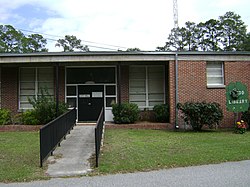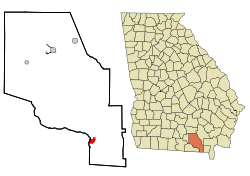Fargo, Georgia
Fargo, Georgia | |
|---|---|
City | |
 Fargo City Hall | |
 Location in Clinch County and the state of Georgia | |
| Coordinates: 30°41′12″N 82°34′1″W / 30.68667°N 82.56694°WCoordinates: 30°41′12″N 82°34′1″W / 30.68667°N 82.56694°W | |
| Country | United States |
| State | Georgia |
| County | Clinch |
| Area | |
| • Total | 2.76 sq mi (7.14 km2) |
| • Land | 2.74 sq mi (7.11 km2) |
| • Water | 0.01 sq mi (0.03 km2) |
| Elevation | 112 ft (34 m) |
| Population (2010) | |
| • Total | 321 |
| • Estimate (2019)[2] | 316 |
| • Density | 115.16/sq mi (44.46/km2) |
| Time zone | UTC-5 (Eastern (EST)) |
| • Summer (DST) | UTC-4 (EDT) |
| ZIP code | 31631 |
| Area code(s) | 912 |
| FIPS code | 13-28744[3] |
| GNIS feature ID | 0314079[4] |
Fargo is a city in Clinch County, Georgia, United States. As of the 2010 census, the city had a population of 321.[5] Formerly a town, it was incorporated by the Georgia state legislature in 1992, effective on April 1 of that year.
Fargo is located near the Okefenokee Swamp and is the western gateway to the Okefenokee National Wildlife Refuge. Also nearby is Stephen C. Foster State Park.
The city was threatened in April and May 2007 by the Bugaboo Scrub Fire, the largest wildfire in Georgia's history.
Geography[]
Fargo is located in southern Clinch County at 30°41′12″N 82°34′1″W / 30.68667°N 82.56694°W (30.686698, −82.567076).[6] Its western border is formed by Suwannoochee Creek, which is also the Echols County line. The Suwannee River forms the eastern border of the city.
U.S. Route 441 passes through the eastern side of the city, leading north 28 miles (45 km) to Homerville, Georgia, and south 39 miles (63 km) to Lake City, Florida. Georgia State Route 177 leads northeast 17 miles (27 km) to its end in the Okefenokee Swamp at Stephen C. Foster State Park.
According to the United States Census Bureau, Fargo has a total area of 2.7 square miles (7.1 km2), of which 0.01 square miles (0.03 km2), or 0.46%, is water.[5]
Demographics[]
| Historical population | |||
|---|---|---|---|
| Census | Pop. | %± | |
| 2000 | 380 | — | |
| 2010 | 321 | −15.5% | |
| 2019 (est.) | 316 | [2] | −1.6% |
| U.S. Decennial Census[7] | |||
As of the census[3] of 2000, there were 380 people, 146 households, and 105 families residing in the city. The population density was 220.3 people per square mile (84.8/km2). There were 174 housing units at an average density of 100.9 per square mile (38.8/km2). The racial makeup of the city was 79.47% White, 18.95% African American, 1.32% Native American, and 0.26% from two or more races. Hispanic or Latino of any race were 0.53% of the population.
There were 146 households, out of which 30.1% had children under the age of 18 living with them, 56.2% were married couples living together, 11.6% had a female householder with no husband present, and 27.4% were non-families. 26.0% of all households were made up of individuals, and 9.6% had someone living alone who was 65 years of age or older. The average household size was 2.60 and the average family size was 3.16.
In the city, the population was spread out, with 26.8% under the age of 18, 7.6% from 18 to 24, 30.8% from 25 to 44, 23.2% from 45 to 64, and 11.6% who were 65 years of age or older. The median age was 34 years. For every 100 females, there were 104.3 males. For every 100 females age 18 and over, there were 93.1 males.
The median income for a household in the city was $32,500, and the median income for a family was $34,500. Males had a median income of $30,179 versus $17,019 for females. The per capita income for the city was $12,380. About 12.3% of families and 12.8% of the population were below the poverty line, including 14.0% of those under age 18 and 25.9% of those age 65 or over.
References[]
- ^ "2019 U.S. Gazetteer Files". United States Census Bureau. Retrieved July 9, 2020.
- ^ Jump up to: a b "Population and Housing Unit Estimates". United States Census Bureau. May 24, 2020. Retrieved May 27, 2020.
- ^ Jump up to: a b "U.S. Census website". United States Census Bureau. Retrieved January 31, 2008.
- ^ "US Board on Geographic Names". United States Geological Survey. October 25, 2007. Retrieved January 31, 2008.
- ^ Jump up to: a b "Geographic Identifiers: 2010 Demographic Profile Data (G001): Fargo city, Georgia". U.S. Census Bureau, American Factfinder. Archived from the original on February 12, 2020. Retrieved July 28, 2014.
- ^ "US Gazetteer files: 2010, 2000, and 1990". United States Census Bureau. February 12, 2011. Retrieved April 23, 2011.
- ^ "Census of Population and Housing". Census.gov. Retrieved June 4, 2015.
- Cities in Georgia (U.S. state)
- Cities in Clinch County, Georgia

